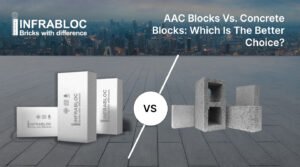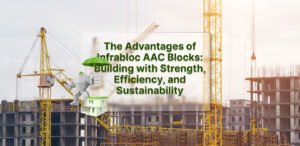Discover the incredible cost-effectiveness of AAC (Autoclaved Aerated Concrete) blocks for your construction projects. In this article, we explore how building with AAC blocks can save you money while maintaining high efficiency. From their efficient production process to long-term savings, AAC blocks offer a smart investment for builders and developers.
1. Efficient Production Process:
AAC blocks are manufactured with precision using a blend of cement, lime, fly ash, water, and foaming agents. Through a curing process in an autoclave, these lightweight yet strong blocks are created. This production method minimizes material wastage and optimizes resource utilization, reducing overall costs.
2. Lightweight Nature:
AAC blocks’ composition of air-filled voids makes them significantly lighter than traditional concrete blocks. This lightweight property eases handling, transportation, and installation, resulting in reduced labour and transportation costs.
3. Thermal Insulation:
The unique cellular structure of AAC blocks provides exceptional thermal insulation. By reducing heat transfer, AAC blocks minimize the need for additional insulation materials. Enjoy energy savings and a comfortable indoor temperature year-round while reducing heating and cooling expenses.
4. Sound Insulation:
In addition to thermal insulation, AAC blocks offer superior sound insulation. Their porous structure absorbs and dampens sound waves, reducing noise transmission between rooms and from external sources. This eliminates the need for extra soundproofing measures, saving on material and installation costs.
5. Durability and Low Maintenance:
AAC blocks have a longer lifespan than traditional building materials. Resistant to fire, pests, and mould, they require fewer repairs and replacements, resulting in cost savings. Additionally, AAC blocks demand minimal maintenance, further reducing long-term expenses for building owners.
6. Eco-Friendly Construction:
AAC blocks promote eco-friendly construction practices by utilizing industrial by-products like fly ash, reducing the consumption of natural resources. The manufacturing process emits fewer carbon emissions compared to traditional concrete blocks, aligning with sustainable building practices. Opting for AAC blocks not only saves costs but also contributes to a responsible and greener approach to construction.
Conclusion:
By embracing AAC blocks, builders and developers can unlock the remarkable benefits of cost-effectiveness. From efficient production processes and lightweight properties to thermal and sound insulation, AAC blocks deliver significant savings in labour, transportation, energy consumption, and maintenance. Furthermore, their eco-friendly characteristics make them an ideal choice for sustainable construction. Invest in AAC blocks for a future that combines economic advantages with environmental consciousness.




